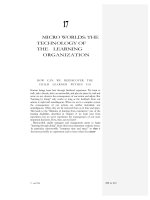MICRO WORLDS - THE TECHNOLOGY OF THE LEARNING ORGANIZATION
Bạn đang xem bản rút gọn của tài liệu. Xem và tải ngay bản đầy đủ của tài liệu tại đây (346.26 KB, 26 trang )
17. září 2004
288 ze 412
17
MICRO WORLDS: THE
TECHNOLOGY OF
THE LEARNING
ORGANIZATION
HOW CAN WE REDISCOVER THE
CHILD LEARNER WITHIN US?
Human beings learn best through firsthand experience. We learn to
walk, ride a bicycle, drive an automobile, and play the piano by trial and
error: we act, observe the consequences of our action and adjust. But
"learning by doing" only works so long as the feedback from our
actions is rapid and unambiguous. When we act in a complex system
the consequences of our actions are neither immediate nor
unambiguous. Often, they are far removed from us in time and space.
This leads to the "dilemma of learning from experience," one of the
learning disabilities described in Chapter 2: we learn best from
experience, but we never experience the consequences of our most
important decisions. How, then, can we learn?
Microworlds enable managers and management teams to begin
"learning through doing" about their most important systemic issues.
In particular, microworlds "compress time and space" so that it
becomes possible to experiment and to learn when the conse-
17. září 2004
289 ze 412
quences of our decisions are in the future and in distant parts of the
organization. While the
computer-based
microworlds described
below
are new, the principle of learning through microworlds is
ac-
tually
familiar to us all.
When they play with dolls, children rehearse ways of interacting
with people. When they play with blocks, they teach themselves basic
principles of spatial geometry and mechanics. Later in life they will
learn the general properties of the pendulum through swinging on a
swing and all about levers through the playground teeter-totter. The
doll, the blocks, the swing, and teeter-totter are what educational
theorists call "transitional objects"; the playroom or the playground is a
microworld, a microcosm of reality where it is safe to play. Through
experimentation with transitional objects in micro-worlds, children
discover principles and develop skills that are relevant in reality beyond
play.
1
They also achieve a rate of learning that is truly astounding. By the
age of three or four, children have learned basic principles of geometry
and mechanics; they have mastered natural language, a feat which
artificial intelligence researchers admit is still on the distant horizon for
machines; and they have learned all about the "social systems" of
home life such as "If I don't clean my room, my mother will." All
without ever being "taught."
Learning through transitional objects and microworlds is not limited
to children. The aeronautical engineer's model in a wind tunnel is a
transitional object in a microworld, as is the naval designer's model
ship in a "wave tank." Managers too have transitional objects and
microworlds. When a work team goes white-water rafting or engages
in some other outdoor team-building exercise, they are creating a
microworld to reflect on and improve the way they work together.
When personnel staff create a role-playing exercise to be used in
supervisory training they are creating a microworld. Many team
retreats serve as microworlds, as illustrated by the "dialogue" practice
sessions discussed in the Team Learning chapter. Consultants often
serve as a transitional object of sorts—a safe sounding board for
exploring new and different business ideas without the risks of
directly putting those ideas into practice.
But existing microworlds for managers are limited. For example,
team-building exercises can produce powerful insights into learning
processes, but they usually do not lead to new insights regarding
strategic business issues. Role-playing exercises can help develop
interpersonal management skills, but they do not show us whether
17. září 2004
290 ze 412
our personnel policies are aligned with our manufacturing and mar-
keting policies. Perhaps most importantly, few existing microworlds
develop individual or team capacities to deal productively with com-
plexity. Few capture the dynamic complexity that confronts the
management team when it seeks to craft new strategies, design new
structures and operating policies, or plan significant organizational
change.
Now a new type of microworld is emerging. Personal computers are
making it possible to integrate learning about complex team in-
teractions with learning about complex business interactions. These
new microworlds allow groups to reflect on, expose, test, and improve
the mental models upon which they rely in facing difficult problems.
They are settings for both crafting visions and experimenting with a
broad range of strategies and policies for achieving those visions.
Gradually, they are becoming a new type of "practice field" for
management teams, places where teams will learn how to learn
together while engaging their most important business issues.
Microworlds will, I believe, prove to be a critical technology for
implementing the disciplines of the learning organization. And they
will accomplish this by helping us rediscover the power of learning
through play. Shell's Arie de Geus says that organizational learning
occurs in three ways: through teaching, through "changing the rules of
the game" (such as through openness and localness), and through play.
Play is the most rare, and potentially the most powerful. Micro-worlds
are places for "relevant play." There the issues and dynamics of
complex business situations can be explored through trying out new
strategies and policies and seeing what might happen. Costs of failed
experiments disappear. Organizational sanctions against
experimentation, either implicit or explicit, are nonexistent. Reflecting
on our own and our team's learning skills can be enlightening and
"lightening" (as in "lightening up") because this reflection can be
separated from the risks and pressures of real decision making.
Today, microworlds for managers are exploring diverse issues
from managing growth to product development and improving quality
in both service and manufacturing businesses. These experiments build
on and incorporate insights about system archetypes, team learning,
and working with mental models. We still have a long way to go before
"practice fields for management teams" are a way of life in learning
organizations. But important principles and tools are emerging that are
pointing the way.
17. září 2004
291 ze 412
What follows are descriptions of three different microworlds taken
from three very different business settings. They illustrate the range of
strategic and operational issues that microworlds can illuminate:
1.
Future Learning:
in which a management team discovers internal
contradictions in a strategy that is only just being put into place;
2.
Seeing Hidden Strategic Opportunities:
in which a team experi
ments with its members' mental models, and discovers that the
assumptions team members hold can shape their customers' pref
erences;
3.
Discovering Untapped Leverage:
in which we invite you to imag
ine playing out the roles of local managers in an insurance com
pany in order to see how deceptively easy it is to "look good
without being good^to mismanage workload in such a way that
quality erodes and potential leverage for improving customer ser
vice and profitability is lost.
Microworld 1
FUTURE LEARNING: DISCOVERING INTERNAL
CONTRADICTIONS IN A STRATEGY
Lying behind all strategies are assumptions, which often remain
implicit and untested. Frequently, these assumptions have internal
contradictions. When they do, the strategy also has internal con-
tradictions, which will prove to make it difficult or impossible to
implement. One benefit of microworlds is bringing these assumptions
into the open and discovering these inconsistencies.
One such case occurred at a highly successful manufacturer of
microcomputers (here called the "Index Computer Company").
2
The
top management team had introduced a microworld as a part of a two-
day planning retreat. They had taken on a strategic goal four months
earlier: to reach $2 billion in sales in four years. They were all
committed to the goal, from Index's President Tom Jamison on down.
And everyone seemed happy with the progress so far.
That's why the vice president of Sales, James Sawyer, felt so
uneasy. It was difficult enough to keep and train his present sales
force—how did they expect him to double it? He had shared his
qualms with other top managers, but they had only responded with
platitudes: "You'll work it out. After all, you'll have the budget for
17. září 2004
292 ze 412
it." Now he was in a bind. He didn't want his fellow executives to
think he lacked their commitment to that magic $2 billion figure. He
didn't want to get the reputation of a "nay sayer." And he certainly
didn't want to let on that he thought he might not rise to the occa-
sion, especially since he had a reputation as a "fixer" who could
solve any problem. But every time he thought about the future, an
involuntary shudder of pain ran through his stomach.
Soon the executives split into three-person microworld teams to
\
play out the consequences of the sales plan. Their first task was to
construct an explicit model on the computer of the assumptions be-
hind the plan.
3
The plan called for a 20 percent annual sales growth, a
continuation of the growth rate of the past ten years. And it also
called for 20 percent more salespeople each year. As they looked at
simulated sales figures for the next four years, it didn't take them
long to recognize that the official plan implicitly assumed that the
productivity of salespeople would hold steady as the sales force
expanded. Hire 20 percent more salespeople, you make 20 percent
more sales.
Making the assumption explicit prompted Sawyer to say, "Well, wait
a minute. Not all salespeople are equal. There is so much they have to
learn—about office automation, software, training, accounting,
engineering, consulting, and manufacturing—before they can place a
single system. Much of our historic growth," he continued, "came
from hiring experienced salespeople whom we lured away from our
competitors. We could do that as long as we were small. But now the
numbers of new hires we need to sustain our 20 percent growth are
getting much larger. We will not be able to get this many people by
hiring away from our competitors. We'll be hiring many more
inexperienced salespeople in the future."
Sawyer's comment sparked a lively debate about the differences in
productivity between experienced and inexperienced salespeople. All
agreed that it was necessary to distinguish new, inexperienced
salespeople from veterans. When they split back into teams, each
team modified their models to make more realistic assumptions.
Sawyer's team, for instance, assumed that veterans would be four
times as productive as rookies. Some groups assumed less, some
groups assumed more, but everyone assumed that training and de-
veloping an experienced salesperson required two to four years.
Now, however, none of the models reached that $2 billion sales
goal. Sawyer's model projected sales under $1.5 billion.
The problem came from the average productivity of the growing
17. září 2004
293 ze 412
sales force. As the computer
simulated the
consequences
of
the
pro-
jected hiring, it showed more and more rookies, because the rate of
new
hires exceeded the rate at which rookies became veterans. Al-
though they hired enough total salespeople to meet their plan, the
mix of inexperienced and veteran salespeople shifted progressively
toward the inexperienced, pulling down average productivity. (The
effects of rapid growth on the mix of experienced personnel, you may
recall, was also an important dynamic at People Express Airlines in
Chapter 8.)
The different work teams tried furiously to find a set of assump-
tions they could believe w^hicfr would produce $2 billion in sales in four
years. No one could do it. To see just how extreme the problems might
become, one group asked the question, "How many salespeople
would
we have to hire if we simply kept hiring until our sales targets were
met?" They found that, "We'd end up almost
doubling
the sales force in
the fourth year alone, if we doggedly kept adding bodies until our sales
target was reached." All knew that this magnitude of personnel growth
would wreak havoc on the sales organization, not to mention the
overall personnel budget.
After an hour, the president stood up and asked, "Is there anyone
here who still believes that our strategic plan is internally consistent?"
No one responded.
The managers had known both halves of the contradiction: that
novices are less productive salespeople, and that the new sales goals
would require them to hire more novices. But the assumptions came
together only when they were put into a microworld that simulated
their interaction over time. Now that everyone could see the internal
inconsistency, Sawyer found himself able to articulate, for the first
time, his general reservations.
"I've felt for some time that executing the new strategic plan will
cause problems," he told the group. "And the problems might be
even worse than even these simulations suggest. We have a tradition of
not revising our business goals once we've announced them publicly.
So, not only would we be likely to hire a lot more new salespeople
than our official plan projects, but there will be a lot more pressure on
our veterans. Couple that with the distractions and frustrations for
our veterans who have to help all these new people get up to speed
and I wouldn't be surprised if we end up with more veterans leaving
and lower productivity from those who stay. We could get into a
really vicious cycle. Many of our veterans came to us in the first place
to escape this kind of situation somewhere else."
17. září 2004
294 ze 412
The other managers sensed that Sawyer's fears might well materi-
alize. "Perhaps," said the president, "it's time to step back and
consider some of the challenges we face." He had hardly finished his
sentence before Susan Willis, the vice president of Human Resources,
had motioned for the floor.
"This is crucial," said Willis. "Our people have some problems
with the sales managers that I'd like to get onto the table." Willis
then talked about the strained relationship between Human Re-
sources and Sales. The sales managers, she said, especially resisted any
call to invest their time in training and developing new salespeople.
Why, she asked Sawyer, were they so reluctant?
"Well, we grew our sales organization by attracting the most ag-
gressive people, the kind of people who spend all their time out in the
field," said Sawyer. "They don't want to mentor any new hires. They
thrive on closing a sale. That's not just where they get their kicks, it's
where they make their money. Thanks to our strong incentives, the
sales managers with high quotas are among the best-paid people at
Index. There are no comparable incentives for helping newcomers; our
organization is a lot stronger at rewarding individual accomplishment."
Then Sawyer added that the new strategic plan would simply rein-
force this problem. "You must keep in mind that our whole sales
organization is geared to meet aggressive targets," he said. "Give
them a tougher target, and they'll respond by selling harder. I'll have a
very tough time getting them to think about taking time in developing
new hires. I understand Susan's problems. I have the same
problems."
The microworld had brought to the surface a set of frustrations
which had been brewing for some time. Moreover, it focused those
frustrations on critical changes which needed to occur if the organi-
zation hoped to sustain past success. Most important, the declining
sales productivity had failed to galvanize action to date, because it
had
not yet taken place in the real world.
The microworld gave them a unique
window on the future.
As their strategy retreat continued, the management team saw the
core issue as either lowering their growth targets or transforming
their sales organization. They concluded that the growth target was
realizable (f new sales people could be trained much more quickly. This
presented a significant challenge, because it meant that veteran
salespeople would need to be more committed to mentoring inexpe-
rienced colleagues. There would need to be new rewards for sales
17. září 2004
295 ze 412
managers to develop their staffs. More support to help senior sales-
people in mentoring and training would be needed. And they'd need
to look more carefully for new hires who wanted to work in a collab-
orative team environment, where people helped one another become
more effective. The changes were significant but achievable.
One tool for change would be another microworld—this one de-
signed for sales managers, in which they could learn to balance,
week by week, their time allocation between direct sales efforts,
recruitment, training, and management. The salespeople could then
discover the long-term benefits of allocating time to personnel devel-
opment rather than to direct sales efforts.
Predictions such as those achieved at Index are different from
normal business forecasts. As former Shell planner Pierre Wack ob-
served: "Suppose heavy monsoon rains hit the upper part of the
Ganges River basin. With little doubt you know that something ex-
traordinary will happen within two days at Rishikesh at the foothills
of the Himalayas; in Allahabad, three or four days later; and at
Benares, two days after that."
4
This is a prediction, not a forecast. It
is something you can say with confidence about the future, because it
depends not on projecting historical data into the future, but on
understanding the dynamics of an underlying system. By analogy, some
of the most interesting learnings that come out of microworlds come
from discovering implications for the future, when decisions play out
in what had been unrecognized organizational systems.
M i c r o w o r l d 2
SEEING HIDDEN STRATEGIC OPPORTUNITIES:
HOW OUR BELIEFS INFLUENCE OUR
CUSTOMERS' PREFERENCES
Some of the most important microworlds help teams mired in con-
flicting views of complex issues. Here, microworlds can be crucial in
surfacing different assumptions and discovering how they can be
interrelated in a larger understanding. Often, our linear language and
defensive ways of presenting our thinking lead to perceiving false
dichotomies and irreconcilable differences. When in fact, as did the
proverbial "blind men," different managers with different types of
business experience are merely seeing "different parts of the ele-
phant." Sometimes, the microworld allows them to "see the ele-
phant" for the first time.
17. září 2004
296 ze 412
Bill Seaver and John Henry are president and VP for marketing,
respectively, of the highly successful Meadowlands shelving company.
3
(As in the first story, some of the specifics here have been changed,
but this is a true story.) Seaver and Henry had come to a basic
impasse in the way they saw their customers and their market. Seaver
believed that the key to success in the marketplace lay in having good
products priced competitively. Henry agreed but also felt that service
quality could play a big part in whether or not customers chose
Meadowlands. He believed that the company should invest in
upgrading its service through training Meadowlands dealers in
performing a wide range of services from better account management
to office design and troubleshooting for all manner of problems that
Meadowlands customers might encounter. Seaver thought these were
good ideas but would not support spending significantly more on
dealer support than they were already because he was convinced that
they would not have significant impact on Meadowlands' sales. "People
expect decent service in our business," he said. "They will not pay
extra for it."
Seaver appeared to have plenty of evidence on his side. For one,
salespeople continually returned to the home office with stories of
how difficult it was to make sales unless they could increase discounts.
"Our competitors are discounting like mad and we can only hold our
own if we match or better them," was the typical refrain. When the
officers talked to customers, Henry had to admit, customers rarely
asked for better or more diverse types of service. Even when Henry
would pursue the point more forcefully, customers would usually
respond, "That sounds nice but what would really make a difference
to us would be another 5 percent off on the big order we've been
discussing with your sales reps." He had to admit that he was the only
one on the top team who took the service idea very seriously, and
even he had to wonder sometimes.
Still, Henry held to his belief that there must be a way to gain
competitive advantage through better service. Unable to resolve
their differences, the two agreed to try experimenting with alternative
strategies in a microworld the team designed on the basis of
assumptions that they did share in common—the distinction be-
tween major purchases (e.g., when customers build a new facility) and
minor purchases (e.g., replacing old shelving in an existing space),
how long customers waited between major purchases, the value
attached by customers to quality of design and manufacture, the effect
of price on purchases, and the volume of current spending on dealer
support. In the microworld, Seaver and Henry were joined
17. září 2004
297 ze 412
by two other members of the Meadowlands management team: Jim
Cortland and Tony Jaynes, the VPs of sales and distribution, respec-
tively.
The four men split into two pairs of partners. Seaver and Henry
teamed up as corporate management, deciding, jointly, how much to
invest to help Meadowlands' local dealers build the infrastructure to
provide customer service. Cortland and Jaynes became the Mead-
owlands sales department, deciding whether and how much to dis-
count prices each quarter in order to reach sales targets. As in real
life, these two decisions were made separately. There was, however, a
common goal: the highest possible profits for the firm, over a five-year
time span.
At the outset of the simulation, a temporary recession caused an
early decline in new orders. Cortland and Jaynes, hoping to maintain
market share, responded by increasing the discount percentage.
Market share held relatively steady but there was a decline in profit
margins, which meant that Seaver and Henry had to reduce their
dealer support investment. Through their combined efforts market
share held steady and margins declined only slightly over the first year.
Unfortunately, the quiet was short-lived. Over the next two years,
Cortland and Jaynes found it necessary to gradually but steadily
increase discounts. To compensate for the ever-declining profits,
Seaver and Henry gave less and less support to dealers. By the end of
three years, price discounts had risen 25 percent and margins had fallen
20 percent relative to the start. Although market share had been
preserved, the team members felt little satisfaction with their business
performance.
In the discussion that followed, Cortland and Jaynes said that the
simulation confirmed their assumption that competitive pricing is
critical. "As we kept going," said Cortland, "it seemed to me that
customers wanted even more discounts than they did at the outset.
When we tried to hold discounts fixed that last year, volume dropped
dramatically"—far more rapidly, he said, than it had when they
fixed discounts early in the game. Seaver said that the experiment had
certainly done nothing to change his mind that pricing was much more
critical than service; he and Henry had found that short-term boosts
in dealer support appeared to have little impact on customer orders,
while cutting dealer support had little apparent adverse affect on
demand. But the overall decline in profitability disturbed him,
especially since it matched what actually had been happening in
Meadowlands' industry in recent years.









